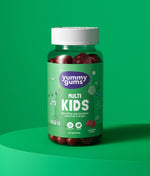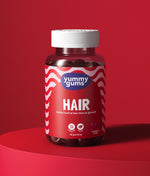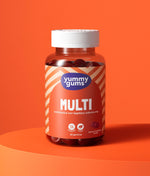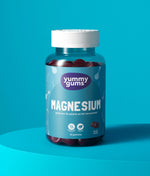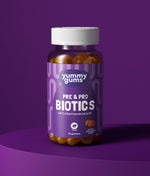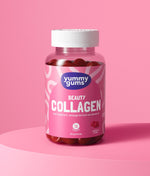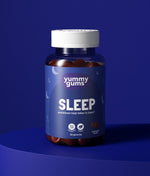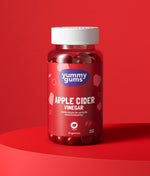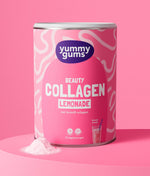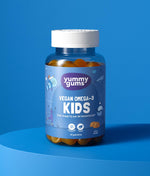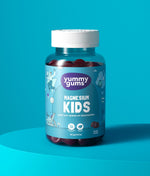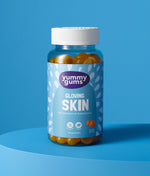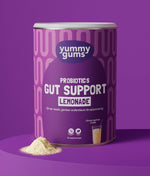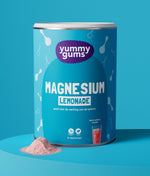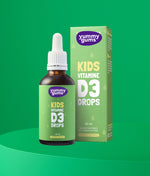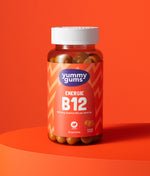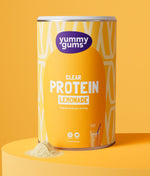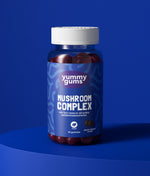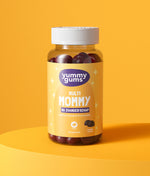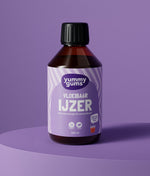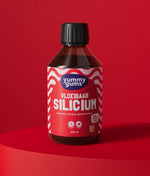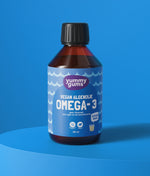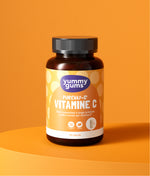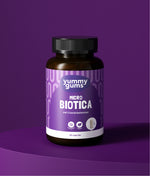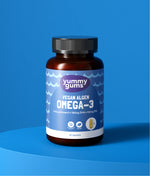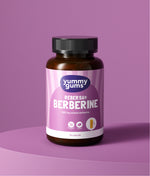Vitamins for hair: everything you need to know
Vitamines
Micronutrients like vitamins and minerals support many processes in your body. These include energy supply, digestion, and immune system function. One of the functions of vitamin A, vitamin B2, B3, B8, and vitamin C is to ensure healthy skin and strong hair (Vitamine Info, 2020). The minerals zinc, iodine, selenium, and copper also play a role in maintaining healthy hair. A deficiency of B vitamins, such as biotin, can therefore be a cause of excessive hair loss (De Nederlandse Haarstichting, 2020). Some cosmetic products add vitamins or minerals, promising that the skin will absorb them. However, your skin can only absorb a small number of substances, meaning a vitamin cream is only effective if it contains a very high dosage. If you want to improve the condition of your skin and hair, getting vitamins and minerals through food and supplements is not only more practical but also more effective.
* The Yummygums Hair is now available in our webshop!
Table of contents
Fat- and water-soluble vitamins
What are vitamins for your hair?
Recommended intake
Selenium
Biotin
Copper
Zinc
What should I pay attention to when buying vitamins?
Different brands
Medical advice
Bibliography
Daily hair loss
Most people have about 100,000 to 150,000 hairs on their head and lose about 100 to 120 per day. This is because the hair on your head grows in cycles: each hair follicle grows about 0.3 millimeters per day (almost a centimeter per month) for 2 to 8 years, after which it enters a two-month resting phase. After these two months, the hair falls out, and a new one grows in its place. Because each hair is at a different point in its cycle, approximately the same number of new hairs are added each day as are lost. Hair loss is therefore quite normal to a certain extent. It's only truly hair loss when you lose significantly more hair daily than before. Thinning hair can have various causes, such as physical or emotional stress, taking antidepressants or contraceptives, or changes in your lifestyle. Consider, for example, a vitamin and mineral deficiency, or the physical stress of childbirth. Besides identifying the causes of hair loss, try not to stress about it unnecessarily. Worrying about your hair loss could cause you to lose even more (Women's Health, 2016), (Vitamin Info, 2020).
Fat- and water-soluble vitamins
Vitamins can be divided into two groups: water-soluble and fat-soluble. Vitamin A, D, E, and K are the fat-soluble vitamins. These can be found in foods high in fatty acids, such as oily fish, oil, and nuts. Water-soluble vitamins are mainly found in foods like vegetables, fruit, and grain products. Your body can partially store fat-soluble vitamins, allowing you to build up a small supply. Your body cannot store water-soluble vitamins. If you consume too much of these vitamins, you simply urinate them out (Eigen kracht, 2019).

What are vitamins for your hair?
These are vitamins that support processes that allow your hair to grow well and stay healthy. Pantothenic acid (vitamin B5) was once said to help prevent hair loss, but unfortunately, there are no proven vitamins that can prevent hair loss. What is certain is that vitamins and minerals help the body during stressful periods. The best vitamins for your hair will be explained in detail later in this article.
Recommended intake
To narrow down which vitamins are good for your hair, it's helpful to know in what quantities you need them. The RDA, AI, and tolerable upper intake levels are used for this purpose. These are explained below:
ADH
The Health Council of the Netherlands recommends the daily amount of each nutrient that healthy people need. These dietary reference intakes are often referred to as the Recommended Daily Allowance ( RDA ). The RDA (or RDA) sometimes leads to confusion. For example, some people need a higher dose of certain vitamins than the RDA. Vitamin supplement labels often state "so much % of the RDA" or "so much % of the RI (reference intake). The reference intake can be compared to the RDA.
Adequate intake
The adequate intake ( AI ) is an estimate of the minimum amount of nutrients that is sufficient for almost all people. This value is used when no RDA can be determined and is therefore not a target value, but an estimate of the minimum amount.
Acceptable upper limit
Consuming excessive doses of vitamins and minerals over a long period of time can be detrimental to your health. To provide a clear picture of what constitutes an "excessive dose," a tolerable upper intake level has been established for each nutrient. This is the highest intake level at which no adverse health effects occur. A different indicator applies to substances that do not occur naturally in food but are added to it. The maximum amount you may consume of these substances without adverse health effects is indicated by the acceptable daily intake ( ADI ). Examples include E numbers, veterinary medicines, and pesticides.
Selenium
Selenium, also known as selenium, is a mineral that promotes hair growth and is important for the overall condition of your hair. Selenium is found in the liver and is an antioxidant : it protects cells from damage. Selenium also supports thyroid function and reduces the toxicity of heavy metals, which sometimes enter food through contamination. In animal and plant products, selenium occurs in the forms selenomethionine, selenocysteine, selenite, or selenate. Selenomethionine and selenocysteine are the most common forms in food and are better absorbed by the body than selenite or selenate.
Power supply
Selenium is found – in small amounts – in both animal and plant products. Meat, organ meats (such as liver), fish, shellfish, whole grains, dairy products, and certain types of nuts (especially Brazil nuts) are rich in selenium. In plant sources, such as vegetables and grains, the amount depends on the selenium content of the soil in which they grow. Selenium is added to almost all animal feed, meaning it also ends up in meat.
Health effects
Your body absorbs an average of 70 percent of the selenium in your diet. However, selenium deficiency is not common in the Netherlands. A deficiency generally only occurs when someone receives parenteral nutrition (nutrition delivered through the bloodstream).
Symptoms of a selenium deficiency include heart problems, muscle pain, and muscle weakness. Getting too much selenium is virtually impossible unless you take supplements with a very high dosage. Selenium is a water-soluble mineral, meaning that if you consume more selenium than you need, you will excrete it in your urine. But the tolerable upper limit exists for a reason: too much selenium can still cause damage in the time between intake and excretion. A selenium overdose can be recognized by loss of hair, nails, and teeth, skin damage, and nervous system disorders.
Recommended intake
The Health Council of the Netherlands has established a guideline for the amount of selenium you should consume daily. This is an estimate of the approximate amount you need. This specific amount is called the adequate intake (Health Council, 2018). The fact that an RDA cannot be established is due to the limited research available on how this value is determined (Health Council, 2018). Because excessive selenium intake has negative health effects, the European Food Safety Authority (EFSA) has established a tolerable upper intake level for selenium.
Adequate intake of selenium (micrograms/day)
| Age | Men | Women* |
| 6 to 11 months | 15 | 15 |
| 1 to 2 years | 20 | 20 |
| 2 to 5 years | 25 | 25 |
| 6 to 9 years | 30 | 30 |
| 9 to 13 years | 40 | 40 |
| 14 to 17 years | 60 | 50 |
| >18 years | 70 | 70 |
*Pregnant and lactating women need 60 micrograms per day.
Tolerable upper limit for selenium (micrograms/day)
| Age | Man/woman |
| 1 to 3 years | 60 |
| 4 to 6 years | 90 |
| 7 to 10 years | 130 |
| 11 to 14 years | 200 |
| 15 to 17 years | 250 |
| >18 years | 300 |
(Health Council, 2018) (Vitamin Info, 2020), (Nutrition Center, 2020)
Biotin
Biotin is the most important vitamin for keeping your hair healthy. It's part of the B vitamins and is also called vitamin B8. You need this vitamin to release energy from food and plays a role in the formation of fatty acids. Biotin also contributes to the maintenance and functioning of your nervous system. It supports hair growth and keeps your hair strong, beautiful, and shiny. Biotin nourishes the skin from within and supports its regenerative capacity (Voedingscentrum, 2020).
Power supply
Biotin is often added to shampoos and other hair products, but its effect is negligible. Biotin is called "biocytin" when it bonds with the amino acid lysine. Biotin, or biocytin, occurs naturally in some foods. Biotin is often used in supplements and as a food additive. This vitamin is found in eggs, liver, milk, soy products, nuts, and peanuts. Eating a lot of raw eggs can lead to a biotin deficiency. Raw egg white contains avidin, a substance that prevents biotin from being absorbed into the body. This effect of avidin does not occur when the egg is heated, such as when cooking or frying.
Health effects
A biotin deficiency is very rare, unless you eat a lot of raw eggs. Skin conditions, anemia, and depression can indicate a biotin deficiency. Biotin is a water-soluble vitamin , meaning that if you consume more biotin than you need, you'll lose the excess through your urine. There are no known adverse effects of a high vitamin B8 intake.
Recommended intake
The Health Council of the Netherlands has determined an adequate intake for biotin that can be used as a guideline for daily intake. This amount does not have to be used as a target value, but it does indicate approximately how much you need. The fact that an RDA cannot be established is due to the limited research available on how this value is determined (Health Council of the Netherlands, 2018). The European Food Safety Authority (EFSA) has not established a tolerable upper intake level for biotin because, as far as is known, no negative health effects have been found with an excess of biotin.
Adequate intake of biotin (micrograms/day)
| Age | Man/woman |
| 0 to 5 months | 4 |
| 6 to 11 months | 6 |
| 1 to 3 years | 20 |
| 4 to 10 years | 25 |
| 11 to 17 years | 25 |
| >18 years | 40 |
*Pregnant women need 40 micrograms per day, lactating women 45 micrograms.
(Health Council, 2018)
(Vitamin Info, 2020), (Nutrition Center, 2020)

Copper
The mineral copper is involved in pigment formation in both skin and hair. Copper also ensures that iron is stored in hemoglobin (the protein that carries oxygen and carbon dioxide in red blood cells) and can thus be distributed throughout the body. Copper is also important for good immunity and your body's energy supply, and it plays a role in the formation of connective tissue and bone tissue. Copper absorption is inhibited by zinc and a daily intake of more than 1500 milligrams of vitamin C. Skin and hair acquire their color through the presence of melanin , also known as pigment. Melanocytes (skin cells that produce melanin) produce sacs containing pigment granules, which are passed on to the keratinocytes. This causes the epidermis—the top layer of skin—to also color.
Power supply
Copper is found in fruits and vegetables, cocoa products, (whole grain) cereals, nuts, organ meats, sea fish and shellfish.
Health effects
Copper deficiency is rare in most people. The risk of deficiency is higher in newborns or premature babies, and children who have been malnourished. Copper is water-soluble , meaning that if you consume more copper than you need, you will excrete it in your urine. Exceeding the tolerable upper intake level is not recommended: too much copper can still cause damage in the time between intake and excretion.
Recommended intake
The Health Council of the Netherlands has established recommendations for the daily amount of copper that healthy people need. These dietary reference intakes are referred to as the Recommended Daily Allowance (RDA). The European Food Safety Authority (EFSA) has established a tolerable upper intake level for copper for safe copper intake.
Recommended Daily Allowance for Copper (milligrams/day)
| Age | Man/woman* |
| 6 to 11 months | 0.3 |
| 1 to 2 years | 0.3 |
| 2 to 5 years | 0.4 |
| 6 to 9 years | 0.5 |
| 9 to 13 years | 0.7 |
| 14 to 17 years | 0.9 |
| >18 years | 0.9 |
*Pregnant women need 1.0 milligram per day, lactating women 1.3 milligrams.
Tolerable upper limit for copper (milligrams/day)
| Age | Man/woman |
| 1 to 3 years | 1 |
| 4 to 6 years | 2 |
| 7 to 10 years | 2 |
| 11 to 14 years | 4 |
| 15 to 17 years | 4 |
| >18 years | 5 |
(Health Council, 2018)
(Vitamin Info, 2020), (Nutrition Center, 2020)
Zinc
Zinc is a mineral that's crucial for strong hair and overall health. Its presence is essential for protein synthesis. Strong hair is less likely to split and therefore stays beautiful longer. Along with numerous enzymes (substances necessary for various processes), zinc is involved in metabolism. Zinc also ensures the proper functioning of the immune system.
Power supply
Zinc is found in small amounts in a wide variety of foods. Foods rich in zinc include meat, cheese, grains, brown rice, legumes, nuts, herring, and shellfish such as shrimp and mussels.
Health effects
In the Netherlands, there are no known cases of people with a zinc deficiency. A zinc deficiency can be recognized by abnormalities of the skin, mucous membranes, and skeleton. Other signs include stunted growth and development of the genitals, reduced immunity to infections, and night blindness. The senses of smell and taste can also be affected, causing altered senses of smell and taste. Furthermore, it is virtually impossible to get too much zinc through food. However, if you take high-dose zinc tablets daily for a long period of time, a copper deficiency can develop. This is because copper absorption is inhibited by the absorption of zinc and vitamin C. Zinc is a water-soluble mineral, meaning that if you consume more zinc than you need, you will excrete the excess vitamin in your urine. Too much zinc can still cause damage in the time between intake and excretion, which is why a tolerable upper intake level has been established.
Recommended intake
The Health Council of the Netherlands recommends the daily amount of each nutrient that healthy people need. These dietary reference intakes are known as the Recommended Daily Allowance (RDA). While it is very difficult to get too much zinc, the European Food Safety Authority (EFSA) has established a tolerable upper intake level for safe intake.
Recommended Daily Allowance for Zinc (milligrams/day)
| Age | Men | Women* |
| 6 to 11 months | 5 | 5 |
| 1 to 2 years | 5 | 5 |
| 2 to 5 years | 6 | 6 |
| 6 to 9 years | 7 | 7 |
| 9 to 13 years | 11 | 8 |
| 14 to 17 years | 12 | 9 |
| 18 to 50 years | 9 | 7 |
| 50 to 70 years | 9 | 7 |
| >70 years | 9 | 7 |
*Pregnant women need 9 milligrams per day, lactating women 11 milligrams.
Tolerable upper intake level for zinc (milligrams/day)
| Age | Man/woman |
| 1 to 3 years | 7 |
| 4 to 6 years | 10 |
| 7 to 10 years | 13 |
| 11 to 14 years | 18 |
| 15 to 17 years | 22 |
| >18 years | 25 |
(Health Council, 2018
(Vitamin Info, 2020), (Nutrition Center, 2020)
What should I pay attention to when buying vitamins?
It's recommended to critically review a supplement's label before purchasing. Check that the amounts in a single serving aren't, for example, 4000 percent of the RDA. Furthermore, more expensive doesn't necessarily mean better: vitamin B8 is and remains vitamin B8. A price difference can be due to the use of different raw materials or additives. Furthermore, the selection of premium brands is often larger than that of store brands (Consumentenbond, 2019).
Different brands
The best-known brands in the Netherlands for vitamins that promote healthy hair growth are Sweet Bunny Hare, Oase, and Yummygums. All three are vegan vitamins in gummy form, making taking your vitamins easy and convenient. Yummygums not only offers a hair vitamin (Yummygums Hair ), but also a multivitamin (Yummygums Multi ) and a multivitamin for pregnant women (Yummygums Mommy ).
Medical advice
If you eat a healthy and varied diet according to theSchijf van Vijf ( Dutch Wheel of Five), you'll get enough vitamins. Unfortunately, that sounds a lot simpler than it is. If you want to check how many vitamins you're getting, use the online food diary "Mijn Eetmeter" (My Food Meter) from Mijn Voedingscentrum (My Nutrition Center ). It's also important to stick to the RDA or RI indicated on the packaging. If no RDA has been established, you can use the AI as a guideline, not as a target. Furthermore, it's important not to exceed the tolerable upper intake level (Vitamin Information Bureau, 2019). Consult your doctor before taking vitamin supplements if you are pregnant, taking medication, or have a medical condition such as alopecia areata. Finally, it's important not to believe all claims made on packaging. Packaging that promises to prevent hair loss isn't always credible.

